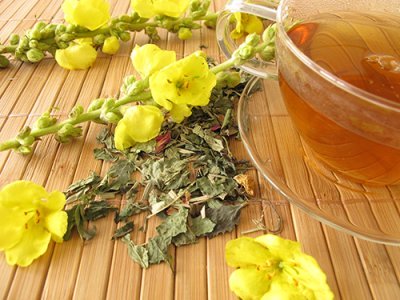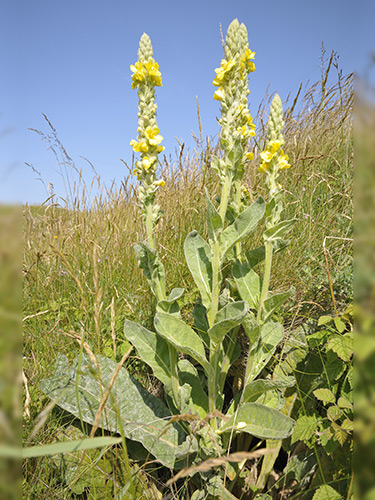Mullein Tea
Mullein Tea is an old friend. At times during the winter and early spring, I find myself with a bunch of softly felted sage green leaves that I'm rubbing in my hands. Then down they go, into a cup of boiling hot water where they'll steep for a while. In 20 - 30 minutes (sometimes longer) I'll pull them out and be ready to drink a steaming hot cup of this delicious, nutritious, and medicinal tea.

This is one of my favorite herbal teas. Mullein has been my lifesaver for curing some of the toughest coughs that hold on like a dog to a bone. If I were to give my praise for one plant and one plant alone for helping alleviate respiratory ailments it would be that wild and wooly mullein. It's also a great tonic for the vascular system. Let's look at the benefits so you know the value you're getting when you make this amazing tea.
The Best Benefits
These very tall stalked plants are renowned for being a great tea for coughs, colds, bronchitis, sore and hoarse throats, chest colds, and many other respiratory problems. The leaves are high in mucilage and contain an immunosuppressant compound that softens and soothes skin, especially the mucous membranes, an inflamed throat, and irritated skin.
Mullein tea is also good for kidney infections. It can be used as a poultice poured over tumors or ulcers on the skin. You can also use this tea as a steam vapor for lung congestion by covering your head with a towel leaning over a big bowl of it for ten minutes or more. And of course, if you have any left over after all these other uses, you can try using it as a hair rinse as mullein is rich in many vitamins that promote hair health and growth.
How to Make Mullein Tea
It's super simple. Submerge a handful of mullein leaves in about 8 oz. of boiling hot water. Steep for 30 minutes or more and you've got yourself a cup of mullein tea.
After you've made your tea you can take it and make a simple cough syrup from it by adding honey. Mullein is versatile. You could also pour your tea into a spray bottle and use it as a general insecticide in the garden on your plants.

A Remarkably simple gift
The wonderful gift of mullein is that it grows almost everywhere. Although native to Europe, it grows all over North America as well. In domesticated places like pastures, fields, roadsides, near train tracks, back lots, and alley ways, even parks. But I've also seen plenty of it grow in the wild as well. With alternate stemmed, lance shaped leaves that are wooly and soft, they're unmistakable, especially in the summertime when their bright sunny-yellow flowers are coming out at the top of the spikes.
So the gift here is that because mullein grows in so many places, it's quite easy to gather the leaves and flowers for making tea. As a guideline, I like to gather herbs and edible plants in places where there are no roads or train tracks. Plants are sensitive and take in car exhaust and other pollutants, and then you're taking that in through the tea you're drinking. So no reason you need to buy it from the store now that you know it grows so commonly. Sometimes as I pass by mullein I'll gratefully gather just a few leaves, tuck them in my pocket and wash them when I get home, dry them well and then slip them into the mullein jar. Often I find it's the shorter spurts of gathering that make it manageable.
Mullein, like their plant comrades, invites us to slow down and leave behind our busy schedules when we gather for making that prized and perhaps long awaited cup of medicinal mullein tea. In doing so, we have the time, space, and awareness for experiencing the often undiscovered and unnoticed lessons, and beauty, that nature offers us.
It's strong taproot is what makes mullein grow in almost any environmental conditions, stabilizing soil wherever it grows. In this way, mullein seems to be a loyal friend, always there even when you're not. Give yourself the gift of gathering for making mullein tea and cultivating a relationship with this plant for a day, a week and then for the rest of your life.
Interested in more herbal tea articles? Take a look at our article about herbal tea recipes here, and our article about herbal tea benefits here.
Additional Resources
When it comes to making mullein tea, these are two of my favorite herbal books because they cover this plant and its medicinal uses as well as so many other common medicinal plants that can be found throughout North America. They are great for basic identification of plants as well as discovering their many uses.
- Peterson Field Guide to Medicinal Plants and Herbs
- From Earth to Herbalist by Gregory Tilford
Interested in being personally mentored in Edible Wild and Medicinal Plants, on a transformational journey of connection to nature, community, and self?
Check out the Twin Eagles Wilderness Immersion Program.
comments powered by Disqus
Return from Mullein Tea to Edible Wild Plants
Return from Mullein Tea to Wilderness Survival (homepage)
Track Us